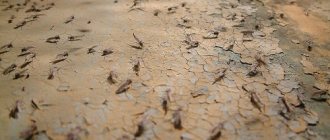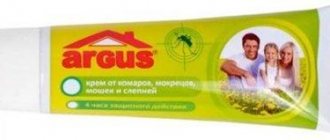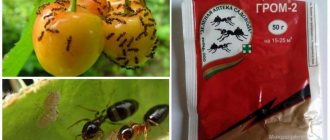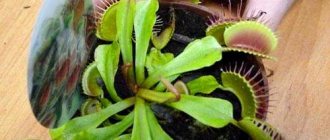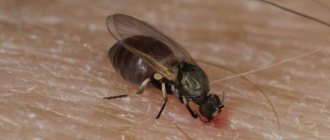Reasons for appearance
The most interesting thing is that there is an explanation for all of the above. Insects choose the most suitable places for living and breeding. And which ones - it depends on the type of midges. But first things first. First, let's figure out how these crumbs appear in the apartment.
There are several reasons:
- Fruits and vegetables are not the freshest . The smell of plant rot is the most desirable aroma for small insects, and spoiled and fermented fruits, juices, compotes, beer are the best delicacy. In addition, this is a very suitable environment for growing offspring. It is worth noting that the female can lay eggs on still ripening vegetables and fruits, and when they get indoors, the larvae will receive the most favorable conditions for growth.
- Wet rags, poorly cleaned or clogged sink . High humidity not only pleases the midges, but makes them simply happy. If you add to the first the accumulated particles of food that have begun to rot, a rotten coating on surfaces and wet rags, and the unpleasant smell of all this, then it immediately becomes clear why insects are in such a hurry to “capture” these territories.
- Flower pots with indoor plants . Many housewives feed their indoor plants with used tea leaves. At the same time, excessive watering leads to rotting of tea leaves, the appearance of particles of rot and mold, plaque and an unpleasant odor. These are ideal conditions for midges. Plus the humidity is constantly high.
- "Generous" neighbors . If midges live with your neighbors permanently, then there is a very high probability that they will also want to visit nearby premises.
- Trash can and bags . A trash can that is taken out at the wrong time will immediately become a haven for small insects. Dirt and the remains of spoiled food will become a feeding ground for both adult midges and their larvae. Waste that has fallen onto the surface of a garbage bag or bucket and has not been noticed is perfect for laying eggs.
- Pets . In this case, it's not about the animals themselves, but about us. More precisely, we are talking about how we take care of our “smaller brothers” and monitor the cleanliness of their place of residence. When algae has grown in the aquarium and the water has stagnated, the cage with the rabbit has not been cleaned, pieces of vegetables are lost in the sawdust of the hamster, and the dog’s bowl has not been washed for a long time, sooner or later the organic matter will begin to rot and attract midges. And they will already find an opportunity to roam and bring offspring.
To summarize, we can say that there is still a danger from midges staying in an apartment. Insects do not sit still, they “travel” to different places and objects. They can start with a rotten apple in a trash can or with moldy soil in a flower pot, and end in the kitchen, on the dining table. The route may be different, but the essence is the same: willingly or unwillingly, they are carriers of many harmful bacteria that can lead to infections. Consequently, the entire life of small insects depends only on human actions, on keeping the house clean and carrying out preventive work.
Interestingly, insects can live in a city apartment all year round. Their number depends on the presence of a favorable environment and temperature. In summer, when the temperature is more than 18°C, they live for about 3 weeks, at low temperatures - about 1.5 weeks, and at zero - the insects die. In addition, larvae and adults die after a few days if they have nothing to eat
Why do midges appear in an apartment?
To get rid of midges in the house, it is important to determine where they come from and their main concentration areas:
- Black, green, and brown midges appear in indoor plants. The reason may be frequent and abundant watering of the earthen clod. The most dangerous are the larvae, which can destroy plants.
- Small flies settle on fruits, berries or vegetables that have been lying around for a long time and begin to deteriorate. These insects are called fruit flies, fruit or vegetable midges, fruit flies; During the breeding process, they attack sweets and drinks.
- Stale garbage can become a source of uninvited guests. For example, a rolled berry, an old kitchen cloth that fell behind a bucket, or food for small rodents and birds scattered on the floor.
- If the deposits on the pipes are not cleaned in a timely manner, sewer midges appear in the toilet. They come out of kitchen or bathroom sink drains.
- Midges can also appear from the apartment of unscrupulous neighbors (typical of multi-storey buildings).
Drosophila love to perch on vegetables and fruits
Types of midges
It would seem that very small midges will not create problems and getting rid of them is a couple of trifles. And this, indeed, may be the case. But only if there are only a few insects, the reason for their appearance is immediately found, measures are taken to eliminate the pests, cleaning is carried out immediately and everything necessary is done to prevent their reappearance. Otherwise, drastic measures will have to be taken in full. Since it is already known how “kids” appear in the apartment and where their favorite places are, we need to find out what they are, whether they are the same or different, what are their differences and characteristic features.
The family of dipterous midges has about 2000 species. This article discusses the most common domestic species.
- Drosophila (wine or fruit midges)
The size of the insects varies from 1 to 3 mm, the color can be light or dark brown, dark yellow, rarely, but orange or black individuals can be found. Most often, midges can be found in the kitchen, where they look for fruits, sweets, and vegetables, which they can eat and lay eggs on. Pests will not ignore fermented juices and alcohol, and will not fly past the sink or trash can.
- Sewer (humpbacks)
The body of insects has a thick “hairy” covering. These midges are delighted with dampness, dark rooms, leaky sewers, a dirty kitchen or a clogged sink. They can become carriers of dangerous bacteria.
- Whitefly
Whiteflies have a characteristic body color; it appears to be covered with powdery white pollen. Insects can reach from 1.5 to 3 mm in length. Midges like warm, rarely ventilated rooms. It’s good if there are indoor plants in the apartment, the soil of which is oversaturated with moisture, then the presence of small pests can be easily determined by the sticky white coating on the shoots. They eat plant sap, and under the leaves you can find larvae that look very much like scales.
- Sciarida (fungus gnat)
Small black midges (from 3 to 5 mm) are also partial to indoor plants. Insects flying over apartment flora are harmless; they reproduce in the soil of flowers oversaturated with moisture, but the larvae grow quickly, taking juices from the roots of plants and nutrients from the soil.
You can also often find pests in homes:
- Wardrobes (they love wardrobes).
- Water (they look for places where the humidity is highest or where there is constant water).
- Gnusov (bite a person).
When the type of midges is known, it is much easier to choose a method to combat them. But, first of all, it is necessary to eliminate the cause of the appearance of insects in the apartment.
Do house flies bite?
At first glance, these little midges look quite harmless and it seems that they will not do us any harm, but in fact they bite more painfully than mosquitoes.
This is due to the fact that during a bite they bite off a piece of flesh, and their saliva entering the wound contains harmful bacteria that cause an allergic reaction, which can manifest itself in different ways:
- the skin at the site of the bite will turn red and be very itchy;
- increased heart rate and increased blood pressure;
- burning and pain at the site of the bite;
- an increase in body temperature, if the bites are not an isolated incident.
When bitten, the first thing to do is wipe the affected area with alcohol, it will help neutralize the poison and relieve discomfort. If the bite site is severely scratched and signs of decay appear, then you need to consult a doctor who can provide you with qualified assistance.
When bitten by a midge, it is strictly prohibited:
- comb the skin at the site of the bite;
- carry out independent treatment with medications without a doctor’s prescription;
- treat the bite site with various household chemicals, as the allergic reaction may intensify;
- Apply the ointment to the wound, as it will cause a burning sensation if it comes into contact. The products are applied around the bite area.
Here are the basic actions and safety measures that need to be taken after a midge bite.
Eliminating causes depending on the type of midges
Different pests require different approaches.
Drosophila in fruit
- Throw away all spoiled fruits, vegetables and fermented berries.
- Get rid of all fruits that are in doubt, as they could come into contact with midges and become carriers of insect larvae.
- Conduct an audit of all available products and carefully check their expiration dates.
- In the room with “tenants”, do a thorough cleaning using household chemicals.
- It is advisable to install anti-mosquito nets with a minimum mesh on the windows.
Humpbacks in pipes
- It is necessary to make sure that the communication systems (sewage, drainage and water supply) are in good order: there are no leaks, rotten areas (on metal risers), accumulation of debris and mucus in the siphons of kitchen sinks and bathtubs, etc.
- Carry out work to eliminate problems with pipes using cleaning and disinfection products.
- To repel or kill insects, use insecticide sprays.
- At least once a week, use special gels or other cleaning products to treat drains.
- Carry out preventive treatments regularly.
Fungus gnats in indoor plants
- Check the flower soil for its moisture level and change the plant watering schedule.
- Make sure that each pot has proper drainage.
- Partially or completely replace the soil, pre-treating it with appropriate fungicides.
- Use mineral fertilizers produced by industry, following the manufacturer's recommendations.
- Periodically treat plants with special chemical compounds.
Midges in the kitchen and bathroom
We get rid of small midges in the bathroom - we clean pipes and siphons with effective detergents. If suitable means are not available, you can resort to traditional methods.
You need to pour baking soda into the sink, and then pour vinegar (you can use citric acid with water).
After the neutralization reaction (there will be active hissing with the formation of foam), rinse the sink thoroughly with running water.
This is also true for the kitchen sink.
Siphons need to be cleaned regularly - at least once a year. Thanks to this, you will maintain hygiene at the proper level, and midges will not appear.
Traditional methods
Many housewives are not supporters of chemistry - today there is enough of it everywhere. Therefore, they successfully use folk methods, homemade traps, or traps that are as safe as possible for humans. Most methods are designed for the insects’ reaction to different odors, and since midges are not fans of aromatherapy at all, the methods are very effective.
Ground cloves (drenched in boiling water)
Apartment midges are not at all delighted with this spice, but it can easily make them run away from the house, as far as possible and as quickly as possible. To do this, pour 5 g of ground cloves into 1 glass of water and put on low heat for 2 hours, achieving a rich, specific smell that repels insects.
Garlic
Many insects cannot stand the smell of garlic, and midges are no exception. Therefore, if you place the cloves of this vegetable (whole or sliced) on shelves or near pots of plants, the midges will scatter in all directions.
Horseradish
Similar to the previous vegetable, you can use chopped horseradish left in the kitchen. The specific aroma of the plant's roots will quickly disperse insects.
Tomatoes
Tomato seedlings or already mature plants growing indoors in pots will become a big problem for the ubiquitous midges. Green tomatoes have a characteristic smell that insects do not like, which means the latter will not stay in the apartment.
Geranium
This indoor flower can, without exaggeration, be called a universal remedy for many insects. Moths, mosquitoes and flies cannot stand the smell of this plant at all; you can safely add midges to their friendly team. Indoor geranium on the windowsill will both decorate the room and protect it from pests.
Essential oils
Insects, indeed, actively react to different odors and to many of them their reaction is negative. Today you can find a wide variety of essential oils that will not only drive pests out of your home, but also fill it with pleasant aromas. If you choose sets of 3-4 oils, the effect will be much better:
- Camphor, cloves and tansy.
- Incense and fir, pine and patchouli.
- Vanilla, geranium, wormwood and tangerines.
- Ylang-ylang, lavender and lemon.
- Cedar and pine, tea tree and juniper.
You can achieve a good effect from the use of essential oils not only with the help of an aroma lamp, but also by applying a few drops of oil to a warm frying pan, to the lampshade, to the radiator (if the heating season has already begun). You can place sprigs of tansy and wormwood in the room on shelves - a bay leaf, or treat the surfaces with a spray bottle of water to which a few drops of any essential oil have been added.
Indoor lemon
An indoor lemon tree will be an excellent ally in the fight against midges. And when crushed in your hands, the leaves will fill the entire room with their aromas and help you forget about small pests for a long time.
Hellebore water
Hellebore water is well known to many as an active antiparasitic agent used to combat head lice. But it has a deadly effect not only on lice, but also on apartment midges. To get rid of flying pests, you need to moisten a dish sponge with the specified solution and place it in the place of greatest concentration of midges for 8 hours. During this time, the insects will die.
Matches
When midges periodically appear on indoor plants, you can use the most ordinary matches (4-5 pieces) to combat them. They need to be stuck into the ground with the sulfur heads down. When the sulfur dissolves, the matches must be replaced with new ones. This procedure must be carried out several times (every other day for a week) to completely expel the pests. Not bad for the same purposes ( freeing flora from insects ):
- Wood ash. Sprinkle the soil generously in the pots.
- Potassium permanganate. Water the soil with a solution of small concentration (very carefully so as not to harm the plants).
- Citrus scented soap. Treat the flower leaves with the prepared soap solution, leave for a while, and then rinse.
- A solution of tar and laundry soap (20 g of soap shavings per 1 liter of water). Water the soil around the plant with a very weak solution.
- Cockroach chalk. Finely crush and sprinkle on the ground.
- Garlic infusion. Chop 3 garlic heads, pour 1 liter of boiling water and let it brew for 4 hours. The product is suitable for treating soil and flower leaves.
How to get rid of small midges?
After finding the location of the midges, you can begin to destroy them.
Chemicals
When removing small midges from an apartment with special chemicals, it is necessary to take into account the general rules:
- Everyone must leave the premises except the person carrying out the treatment;
- carry out the procedure in a respirator and rubber gloves;
- put all products in the refrigerator;
- The treatment is carried out in the morning so that the smell has disappeared as much as possible by the time the family returns.
Before starting work, read the instructions from the manufacturer.
Dichlorvos
An effective method of controlling domestic parasites. Release form: aerosol in cylinders of 300 and 500 ml. The active components have a depressant effect on the midge nervous system. Insects do not die immediately; upon contact with treated surfaces, a chain reaction of infection of relatives is caused.
Manufacturers have released a completely new drug, Dichlorvos Neo, which does not have a pungent odor, but contains active ingredients of the same toxic group.
More on the topic: Worms in herring - are they dangerous for humans?
Dichlorvos - a simple means to combat midges
Spraying should be done in an even layer at a distance of 30 cm from surfaces, special attention should be paid to the trash can. Windows must be kept open during treatment and for 1 hour after it. After the procedure, be sure to wash all surfaces with detergent.
Raptor
The drug is available in the form of an aerosol in a metal container. A volume of 350 ml is enough to treat a room of 30 square meters. m. A stream of the drug is sprayed for 5-7 seconds around the entire perimeter of the room. Toxic components instantly act on midges, causing paralysis and death of insects. Long-acting spray, effective up to 3 weeks after treatment.
Raptor effectively destroys house flies
Reftamide
The spray clears the room of all types of midges. A fairly effective composition gets rid of midges in just 1 application. To combat midges, you should purchase Reftamid-Strengthened or Reftamid-Maximum. The effect of the drug lasts for 4 hours when sprayed in the air and 15 days when treating surfaces or fabric.
Reftamid fights all types of midges
Treatment should be carried out at a distance of up to 25 cm from surfaces, spraying time - up to 1 minute. The aerosol has a rather pungent odor with notes of sweet vanilla.
Raid spray
One of the best remedies against midges. The spray in a 300 ml can has a depressant effect on the nervous system of insects, leading to paralysis and death of midges. Affected midges transfer the toxic effect of the reagent to their relatives, increasing the penetration area of the drug.
Raid is the most effective remedy for midges
Spraying in the room should be carried out from the center to the walls no closer than 1 m from the surfaces for 7 seconds. The effect lasts for 2 hours after treatment.
How to fight with folk remedies
Traditional methods of fighting fruit flies:
- Smoking with camphor. Heat a pinch of powder or 10-20 drops of oil in a frying pan until steam appears. Then go around all the rooms with the frying pan. The smell of midges, which is harmless to people and pets, cannot be tolerated.
- Fruit midges cannot stand the smell of tomatoes. In summer and autumn, when midges appear most frequently, you can easily find a tomato shoot. A plant in a pot on the kitchen windowsill will bring double benefits: it will get rid of midges and will delight you with the harvest.
- A decoction of 5 g of cloves, boiled in 1 glass of water for 2 hours, will help remove parasites forever. You can enhance the effect with lemon. To do this, cut the citrus into 2 halves and stick up to 10 pieces of cloves into the pulp. 2-3 lemons per room will be enough to completely destroy midges.
- Aroma oils. Basil, anise, eucalyptus are the best helpers in creating a cozy microclimate in the apartment. 5 drops of any scent can be heated in an aroma lamp. The second way is to apply 5-10 drops onto napkins, which are then spread on free kitchen surfaces. For an area of 10 sq. m will need 2-3 napkins. These oils cannot be mixed; they will lose their beneficial properties.
- An unwashed bottle of sweet juice or low-alcohol drink left overnight will be filled with vegetable midges in the morning. Just pack it up carefully and throw it away.
- Finely chopped garlic can be placed in the soil of the affected plants. With its help, you can not only destroy flower insects, but also carry out disinfection during respiratory diseases.
More on the topic: Parasites in the human liver
Clove decoction has a negative effect on midges
You can apply a trail of any wine along the entire length of the adhesive fly tape. Only 10-20 g of drink will be required. Midges will instantly flock to your favorite scent. For greater effectiveness, several baits should be placed in the room. If midges appear in cereals, tapes must be hung inside the cabinets.
Midge traps
Traps made at home are effective.
- Place the sweet fruit in a small container. Then you need to close the neck with polyethylene, leaving several small holes. The smell will attract wine midges. The trap can be left overnight. Midges will fly to the tasty bait through the holes. Once filled, the container should be hidden in a plastic bag and thrown away. If necessary, you can repeat the procedure several times.
- Wine vinegar with a drop of detergent is a favorite treat for midges. The mixture should be poured into a saucer and left for a while, then washed off along with the midges under running water.
Important!
You can also use a special trap for midges “Raptor”. One device is enough for an area of 12 square meters. m. The action continues for a month. The composition includes a special liquid, cardboard with an adhesive composition applied to the surface, and instructions. The aroma attracts midges, the sticky surface prevents them from getting out.
Other effective ways
- A modern way to deal with uninvited neighbors is a vacuum cleaner. Using a pipe without a brush at maximum power, remove the places where midges settle the most. It is important not to release them back after the process is completed. Therefore, it is better to immediately remove the garbage bag and pack it in a bag.
- A fumigator used against mosquitoes. If you turn it on in the habitat of midges all night, in the morning there will be no trace of them left.
You can fight midges using a fumigator
With a spray bottle and humidifiers, you can achieve good results with periodic use. Wet wings will prevent midges from flying. The room should be constantly moistened.
Homemade traps
The advantage of self-made traps is that they are completely safe for people, and for making them you can use the simplest and most affordable means at hand.
Glass jar
To attract insects, place a few pieces of spoiled fruit or pour a little beer, jam, sugar syrup, etc. at the bottom of a glass jar (volume 0.5 l or 1 l). Cover the top of the container with cling film or a cellophane bag. Make several small holes in a well-tightened “lid”, which will become “entrance doors” for midges rushing to the treat. But the midge will no longer be able to get back out.
Instead of a can, a disposable plastic cup is often used, but paper can be an alternative film option without any problems. Just don’t cover the neck of the jar with it, but make a funnel with a small hole at the end. Insert the resulting cone into the jar with the bait, tip down, cover the joints with tape and the trap is ready. If plastic devices can be disposed of along with midges, then what to do with the jar? There is an opinion that a jar closed with a polyethylene lid can be placed in the microwave for 30-40 seconds at a power of 600-700. All insects will die, and nothing will happen to the container.
Plastic bottle
Cut off the top part of a 1.5-2 liter bottle. Turn the resulting cone over and insert it into the remaining lower part of the container. To ensure that there are no gaps left, seal the joints of the two elements (on the side) with tape. Place your favorite midge treats at the bottom of the structure. For insects that get inside, there is no way back.
Detergent solution
The trap is convenient because you don’t have to figure out what to cover it with or how many holes to make. Everything is very simple. Fill any container ¼ full with warm water, add 1 tablespoon of apple cider vinegar and 1 teaspoon of dishwashing liquid or shampoo (the amount is given per 0.5 liter jar) - the device for catching midges is ready.
Plastic bag
The simplest version of the trap. You need to put a rotten piece of banana or a few “stale” apple cores in the bag. Open the package slightly and wait until the insects have settled inside and there are a sufficient number of them. When you decide: “It’s time!”, the trap must be carefully and quickly tied, and then thrown away along with the contents.
The bait for annoying midges can be sour or sweet liquids: apple and wine vinegar, wine, juice, beer, compote or honey
Brew trap
Midges will never fly past dessert wine or beer. To lure insects into a trap, it is enough to leave an open, empty, but not washed bottle of “tempting” drinks on the table. In less than a couple of hours, there will be an incredible number of fruit flies inside the trap. All that remains to be done is to quickly plug the cap and throw away the bottle.
Milk, water and formaldehyde
An effective trap that can be placed not only in problem areas, but also on a table or windowsill. The composition is prepared from water, milk and formalin in proportions 5:3:1. The mixture is poured into a plate or not very deep bowl and placed in the place of greatest concentration of pests.
Milk with pepper
The proposed trap is made similarly to the method described above. Add 4 tablespoons to 1 glass of warm milk. lie ground (black) pepper and 8 tbsp. lie Sahara. The mixture is boiled for 10 minutes over low heat, and then a small plate is filled with it and insect catching begins. You can soak sheets of paper in this solution and hang them over areas where midges accumulate. Diptera will be tempted by sweet and peppery baits, for which they will pay with their lives.
Pets
Pets themselves do not cause midges. However, their habitats may be the cause. Therefore, you need to replace sand or other filler in time. In this place, putrefactive processes can begin, resulting in the formation of midges.
Pet feeding containers should be washed immediately. The remaining food begins to rot, causing midges to appear.
Mechanical methods
The action of some products requires a certain period of time and the insects, accordingly, will disappear gradually. Not everyone wants to use chemicals. Those who can no longer tolerate the presence of midges and want to get rid of them as quickly as possible (this may be most of the swarm) should try the following methods:
Vacuum cleaner
Household appliances are always a reliable assistant in the home. Therefore, many consider a vacuum cleaner an effective means of combating midges. Although they can only collect a large cluster of midges, and even then, some will still run away, and the next day they will have to hunt for the next “batch.” Nevertheless, portable vacuum cleaners are quite popular - I tracked down insects, caught a few and it became easier - at least some of the pests were destroyed. To increase the number of pests caught, you must first set a bait that will gather a large swarm around itself, and then turn on the vacuum cleaner at full power.
Hydration
With the help of a spray bottle, you can indeed moisten the wings of insects and the latter will not be able to fly. This method works, but has several nuances. You immediately need to think about where to quickly remove the midges, and, secondly, correctly calculate the degree of moisture, so that later you do not have to fight the flood.
Ventilation
Ventilation of the apartment must be carried out regularly and without fail. Good air circulation will prevent the appearance of unpleasant odors and excess dampness. Through ventilation can remove a considerable amount of midges from the house.
Smoking
The method is based on insects’ intolerance to strong specific odors. There are several options, but before using each of them, you need to make sure that no one in the house is allergic to the components used.
- Camphor in a frying pan
To make camphor work and release the characteristic smell of wormwood, you need to pour the powder into a well-heated frying pan. With such an amazing scent, you can go around all the rooms or leave it until it cools down in the room with the highest “concentration” of midges. In the absence of camphor, clove oil or verbena will be no less effective.
- Incense
The phrase “he’s as afraid as the devil of incense” can easily be applied to midges. Fumigation will force insects to quickly and permanently leave the occupied territory. There is no incense - it’s also not a problem; you can safely take sprigs of thyme, pine or juniper for burning.
Mosquito nets
It seems like I installed a mosquito net and not a single insect will penetrate the house, but they break through even such protection. It's all about the cell size (from 0.6 to 1.2 mm) and it cannot always stop midges.
Then additional protection is applied:
- The “old-fashioned” way is to buy the most inexpensive nylon tights, cut them and add another layer of mesh.
- Chemical repellents are sprays that can be applied to the mesh, and they will repel midges.
- Natural helpers - vanillin dissolved in vodka or water, sprayed over a mesh from a spray bottle, and essential oils of eucalyptus, lemon balm, lemon or tea tree are applied using a cotton swab. After such treatment, you can be calm - not a single midge will get into the apartment.
Traditional methods
You can use traditional methods to combat midges.
These include:
- Vacuum cleaner . With its help, you can get rid of midges; to do this, you need to turn it on at full power and direct the suction tube to places where insects accumulate. It is recommended to clean the container or bag away from the house so that they do not return.
- Smoking out midges is another method of control that has proven itself. To do this, we need a piece of camphor (a white crystalline substance used as a medicine), which must be crushed and placed on a roasting pan. As soon as steam appears, you will need to take a brazier and walk around the home. House flies hate it, but it is safe for humans and pets.
- Homemade traps . Can be made from a plastic cup or jar. To begin with, place pieces of sweet fruit on the bottom or pour in a little juice, wrap the top of the neck with cling film and make several holes through which insects will penetrate. We leave it overnight, and in the morning you will be surprised how many midges have got there.
Chemicals
If all of the above methods do not give the desired result and the number of midges in the room becomes catastrophic, “heavy artillery” enters the battle - ready-made means of varying degrees of toxicity and intensity of action. In the proposed list of funds we will move from less powerful to more active.
Repellents
The principle of operation of effective repellers is simple: a special strip impregnated with the active substance is placed in a tank. When the active composition begins to act, the midges either die or rush to leave the home. What you must do after using this product is to regularly ventilate the room well. Among the most popular are “Gardex” and “Breeze-Anti-Mosquito”.
Light traps (zappers)
Special electric traps are among a number of new devices for killing insects. The operating principle of the device is based on the enormous “love” of midges for light. The dipterans rush towards the soft light emitted by the lamp, fall on the internal metal mesh, which is always under voltage (safe for humans), and die. Such traps are quite easy to install, and their obvious advantage is the absence of chemicals.
Glue traps (industrial)
Sticky traps offered by the industry are among the most harmless and affordable means of insect control. They are best used in areas where food is prepared or stored. Velcro tapes should be unrolled and hung under the kitchen ceiling, the result will be visible the very next day.
Velcro, made on a flat surface, is great for killing insects in plants. The device is installed in the ground so that it does not interfere with the flower, and with an alluring aroma it takes on the entire “blow” of the pests. The best representatives of the drugs in this series include: “Flies Away”, FT 001 with an attractant and “Bros”, “Silvalure”.
There are Velcro that fold into the shape of a house, they are effective, they can be placed on shelves, near products, and they have an attractive, clean appearance (“Raptor”, “Aeroxon”).
Fumigators
Compact devices are designed to activate insecticides by heating (fumigators operate from an electrical network). The latter are part of the liquid that fills small reservoirs or special plates. A correctly selected product is designed for a specific area and will ensure the absence of midges in a certain area for a sufficiently long period of time (“Combat”, aquafumigator “Raptor”).
Aerosols
The use of aerosols requires mandatory compliance with all manufacturer's recommendations and compliance with safety precautions. Considering that the chemicals will work for a certain time indoors, it is worth taking care of children's things, toys and food. All of the above must be carefully packed or hidden.
It is important to remember that aerosols and sprays with insecticides can only be used in well-ventilated areas. It is better not to use such products in the children's room and kitchen; if necessary, then act with special attention and caution.
“Combat”, “Raid”, “Dichlorvos”, “Hexachloran”, “Chlorophos”, “Raptor” are some of the most effective means that are used against house flies. And, even if their modern analogues have a pleasant smell, we must never forget that the active substance of these drugs is poison.
Prevention methods
As practice shows, it is much easier to prevent a problem than to deal with its consequences later. This also applies to midges. Keeping your home clean and carrying out preventative maintenance is not as difficult as it might seem.
Enough:
- Take out the trash regularly and keep the trash can clean.
- Periodically check food products for freshness and compliance with expiration dates.
- Spoiled food should be thrown away immediately, or better yet, taken out of the house immediately.
- Keep the sink, bathtub and toilet clean, promptly clear blockages, monitor the passage of siphons and disinfect them (“Floop”, “Perffi div”, “Mole Turbo”, “Pothan”).
- Constantly monitor the cleanliness of your pets' aquariums, cages, trays and bedding.
- Properly water indoor plants and periodically treat the soil with preparations from specialized stores (“Aktara”, “Aktellik”).
- When cleaning, use essential oils or products with a strong odor, which midges are not at all happy with.
- Install mosquito nets (in warm seasons).
Preventive measures
In order to prevent the formation of midges in an apartment or house, you need to take preventive measures and follow some simple recommendations:
- maintain an appropriate level of hygiene in the home;
- Do wet cleaning more often, wash furniture surfaces and floors;
- do not forget to throw away garbage, it is the most common cause of midge formation;
- At least once a year, clean all siphons in the house, this applies to both the kitchen and the bathroom;
- Get rid of spoiled food in a timely manner. It’s impossible to eat them anyway, but midges are guaranteed to appear.
For preventive purposes, you can resort to persistent pungent aromas. For example, midges are afraid of geranium and camphor.
- How to get rid of fruit flies - where do they come from and tips on how to quickly and easily get rid of fruit flies at home (105 photos)
Flies in the apartment: effective methods and recommendations on how to get rid of flies (110 photos and videos)
How to get rid of fleas in an apartment: where they come from, how to fight and tips on how to get rid of fleas quickly and easily (100 photos and videos)
They also can't stand incense, but be careful, many people don't like the smell.
The smell of garlic also actively helps fight midges. Naturally, odors cannot completely eliminate the likelihood of midge formation, but they do a good job of minimizing this likelihood.



